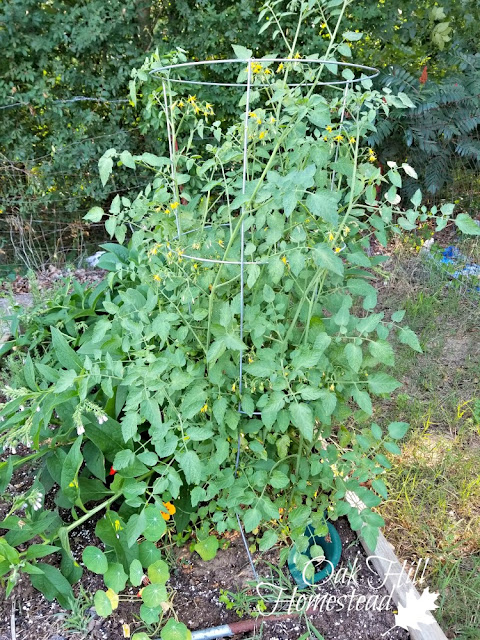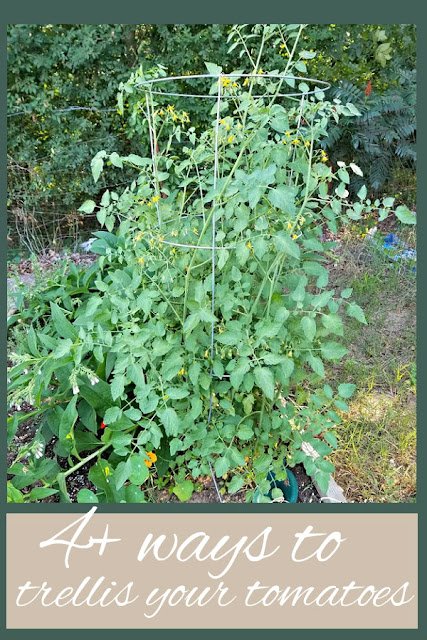Using trellises to support your tomato plants not only saves space but also promotes healthier plant growth, makes harvesting easier, and also adds visual appeal to your garden. Here are the best tomato trellis ideas to support your tomato plants
Best Tomato Trellis Ideas
A trellis is simply a framework, usually made from metal or wood, that supports large plants.
Trellises are most-commonly used to support tomato plants, keeping the plants (and the tomatoes themselves) up off the ground. But trellises don't have to be limited to tomato plants.
Any vegetable plant that sprawls along the ground and has a vining habit can be grown on a trellis, such as peas, cucumbers, small melons, gourds and pole beans are all easily grown on a trellis as easily as tomato plants.
The benefits of using trellises in your garden
Some trellises are simply ornamental for use in the flower garden, providing visual interest or supporting a pretty vine. However, using trellises in the vegetable garden offers many benefits as well.
- A trellis increases the space in your garden by allowing you to grow large plants vertically. You can grow more plants in a small area by using a trellis. They are a great way to maximize the space you have, and to increase the productivity of your garden.
- A trellis allows better air circulation around your plants, which reduces the risk of certain diseases caused by moisture buildup. Training plants to grow upwards on a trellis also keeps the ripening fruits off of the ground, which prevents rot.
- Increased exposure to sunlight promotes healthy growth.
- Trellises allow easier access to your plants and make harvesting your ripe tomatoes so much easier.
- A trellis will also add visual appeal to your garden. Strategically placed trellises can even provide some privacy during the growing season.
A trellis isn't just for tomato plants
Quite a few garden vegetable plants will benefit from being trellised.
Cucumbers, beans and melons like to grow up a trellis too. Any vining plant can be trained up a trellis.
Other plnats such as squash and zucchini can also be grown on a trellis. More air and more sunshine on your plants can help prevent powdery mildew, and will keep fruit off the ground so it won't rot as quickly.
Why trellis tomato plants?
Tomatoes come in two types: determinate and indeterminate. The type you're growing might make a difference in the kind of trellis you should use.
Determinate tomato plants grow to a certain size, produce fruit all at once and then quit for the season.
These are often grown by people who can tomatoes and tomato sauces because they ripen at the same time.
On the other hand, indeterminate tomato varieties keep growing vigorously throughout the growing season and produce tomatoes during the whole season. They can get out of control very easily.
The determinate plants aren't as large and heavy and can be supported by a lighter-weight trellis such as the wire tomato cages. Indeterminate plants can grow very tall, very large and be very heavy. They need a stronger type of trellis, such as the A-frame trellis.
Some common ways to support tomato plants
There are as many ways to trellis plants as there are gardeners. Here are half a dozen trellis ideas you can try, and decide for yourself which is the best way to support tomato plants.
Of course, the least expensive way is to use materials you have on hand and make a DIY tomato trellis, while the fastest and easiest is to go buy a ready-made product. I've included some of each.
Tomato cages
Tomato cages are probably the first thing you think of when growing tomatoes. Tomato cages are easily found at garden centers and aren't very expensive.
These cages are rather flimsy and tend to topple over when the tomato plant gets huge as indeterminate tomato varieties do. Cages are better for determinate tomato plants that don't get as large.
I've found that tomato cages usually last only one season, which makes them more expensive in the long run.
Tomato towers
Towers are similar to cages, but stronger. They are a bit harder to find in stores, and they cost more, but they are a better tomato support than the flimsy wire cages are.
They fold flat for storage and mine are holding up well on Year Two. They also look nice in the garden if that's important to you.
Florida weave
The Florida weave method holds tomato plants upright between stakes or poles. Two or more plants are planted between the stakes, and twine is woven from stake to stake, around each plant.
I've used this method a few times in the past, but it took a lot of stakes and twine and continuous tending. As my plants grew large, I needed taller stakes and stronger twine, and the whole thing was rather unwieldy.
The Florida weave trellis also works better in a garden row rather than in a raised bed.
Wire fencing cages
You can make your own sturdy cages by forming a circle of wire fencing around each tomato plant. Attach the two ends of the fencing into a circle with wire or strong cable ties ("zip ties").
Concrete mesh works well instead of fencing, if you can find it.
You may need to add a stake or t-post to the fencing circle to help hold these cages upright, especially when the tomato plant gets large and top-heavy. At that stage you might need two stakes, one on each side of the plant.
Depending on the type of fencing, you might want to cut a few hand-size or vegetable-size holes in the wire to make harvesting easier.
The downside of this method is that the circular cages can be hard to store over the winter, unless you can open the circle and store them flat.
Stakes and posts
Tomato plants can be tied to t-posts or stakes, one plant per stake. If you use this method, drive your stakes in when you plant your tomatoes so they won't disturb or damage the plants' roots by being driven in later.
Cattle panel arch
An arched trellis made with a cattle panel is sturdy and visually pleasing. It can accomodate a variety of climbing vegetable plants including tomatoes.
Cattle panels are available at farm supply stores and feed stores. They come in 16-foot lengths and can be cut with a rotary cutter or bolt cutters if needed. We used the entire 16-foot length and did not have to cut it.
Our cattle panel arch is placed between two of our raised garden beds which are four feet apart, and attached to the side of the beds with heavy-duty fencing staples. It withstood a tornado in April 2023!
If you prefer to place your cattle panel arch on the ground, use two metal t-posts or wooden posts in the ground on each end, and attached the panel to the posts with heavy-duty wire.
Plant tomato plants along the base of the trellis and train them to grow up and over the arch.
Want to know how tall your cattle panel arch would be, or how wide you need to make it so it will be a certain height? Check out this cattle panel arch calculator.
A-frame trellis
The A-frame trellis is my favorite tomato trellis. It's simple to make, easy to store during the off-season, and does a good job of supporting tomato plants.
I use cattle panels that have been cut in halves or thirds. A cattle panel is 16 feet long, so this gives me two 8-foot long sections or three 6-foot long sections. You can cut them to fit the length of your raised beds using a rotary cutter or bolt cutters. You'll need two sections for each A-frame trellis.
Stand two of the panels along the long side of the raised garden bed, one on each side, and let them lean against each other at the top to make a tent shape (you know, an A-frame). Attach the two panels together at the top with baling wire or string.
The bottom of the panels are pushed against the boards that form the sides of the raised bed. The shape of the A-frame makes it steady and sturdy.
It can be a bit interesting putting this tomato trellis together by yourself. A second pair of hands would make it easier: one person to hold the first panel in place and the other to set up the second panel and then attach them at the top.
(Now that I'm writing out the directions, I realize I could have wired the two panels together before I put it in the bed. That would have been much easier!)
As the tomato plants grow, tuck them into the next open hole of the panel, weaving them in and out. You can tie them in strategic places with string or use strips cut from old t-shirts, which are stronger yet gentler than string.
Be sure to set up your A-frame trellis before your tomato plants get too large and are more difficult to train. Be gentle as you weave the stems in and out of the squares on the cattle panels, as they can break easily. (Did you know that you can root tomato stems that have broken and have another plant?)
In conclusion, incorporating trellises into your vegetable garden can revolutionize your growing experience.
From the simple tomato tower to the sturdy and eye-catching cattle panel arch, these structures offer numerous benefits. By utilizing tomato trellises, you can optimize your garden space, enhance your plants' health, simplify harvesting, and create a visually appealing landscape.
So, pick a trellis style and watch your tomato plants thrive as they reach new heights with the help of trellises.
~~~~~
My hope is to inspire you, and to encourage your homesteading plans and your dreams of a simple, self-reliant, God-dependent life. You can follow me at:
Facebook | Pinterest | Instagram | Subscribe














.jpg)









